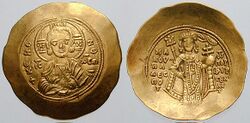هايپرپايرون

هيپرپيرون أو هيپرپيرون ( hyperpyron ؛ باليونانية: νόμισμα ὑπέρπυρον nómisma hypérpyron) كانت عملة بيزنطية اِستُخدِمت في أواخر العصور الوسطى، لتحل محل السوليدوس كالعملة الذهبية العيارية في الإمبراطورية البيزنطية في القرن الحادي عشر. وقد قدّمها الإمبراطور ألكسيوس الأول كومننوس.
التاريخ
The traditional gold currency of the Byzantine Empire had been the solidus or nomisma, whose gold content had remained steady at 24 carats for seven centuries and was consequently highly prized. From the 1030s, however, the coin was increasingly debased, until in the 1080s, following the military disasters and civil wars of the previous decade, its gold content was reduced to almost zero.[1] Consequently, in 1092, Emperor Alexios I Komnenos (r. 1081–1118) undertook a drastic overhaul of the Byzantine coinage system and introduced a new gold coin, the hyperpyron (meaning "super-refined"). This was of the same standard weight (4.45 grams) as the solidus, but only 20.5 carat purity (0.854 fineness) instead of the standard 24 carat, resulting in a reduced gold content of only 4.1 grams instead of 4.8 grams. The lower purity was due to melting down and inclusion of earlier debased coins.[2]
The hyperpyron remained the standard gold coin until gold coins ceased to be minted by the Byzantines in the mid-14th century. It too, however, was subject to gradual debasement: under the Empire of Nicaea (1204–1261), its gold content fell gradually to 18 carats, under Michael VIII Palaiologos (r. 1259–1282) to 15 and under his son and successor Andronikos II Palaiologos (r. 1282–1328) to 12 carats. At the same time, the quality of the coins declined as well, and in the 14th century, their weight was far from uniform.[3] The last hyperpyra, and thus the last Byzantine gold coins, were struck by Emperor John VI Kantakouzenos (r. 1347–1352). The name remained in use thereafter solely as a money of account, divided into 24 keratia.[4]
The name was adopted in various forms by Western Europeans (لاتينية: perperum, إيطالية: perpero) and the Slavic countries of the Balkans (perper, iperpero, etc.) designating various coins, usually silver, as well as moneys of account.[5] More often in the West the hyperpyron was called the bezant, especially among Italian merchants.
In the early Komnenian period, the hyperpyron was the equivalent of three electrum trachea, 48 billon trachea or 864 copper tetartera, although with the debasement of the trachea it eventually came to rate 12 electrum trachea and 288 to 384 billon trachea.[6] In the 14th century, the hyperpyron equalled 12 of the new silver basilika, 96 tournesia, 384 copper trachea and 768 copper assaria.[7]
انظر أيضاً
الهامش
- ^ Grierson 1999, p. 10.
- ^ Grierson 1999, p. 11; Kazhdan 1991, p. 964.
- ^ Grierson 1999, pp. 11–12.
- ^ Grierson 1999, p. 12; Kazhdan 1991, pp. 964–965.
- ^ Kazhdan 1991, p. 965.
- ^ Grierson 1999, p. 44.
- ^ Grierson 1999, p. 45.
مصادر عامة ومذكورة
- Grierson, Philip (1999). Byzantine Coinage. Washington, DC: Dumbarton Oaks. ISBN 978-0-88402-274-9. Archived from the original on 2013-12-14.
- Kazhdan, Alexander, ed. (1991). The Oxford Dictionary of Byzantium. New York and Oxford: Oxford University Press. ISBN 978-0-19-504652-6.
للاستزادة
- Grierson, Philip (1982). Byzantine Coins. London: Methuen. ISBN 978-0-416-71360-2.
- Hendy, Michael F. (1989). The Economy, Fiscal Administration and Coinage of Byzantium. London: Variorum Reprints. ISBN 0-86078-253-0.
- Hendy, Michael F. (1985). Studies in the Byzantine Monetary Economy c. 300–1450. Cambridge: Cambridge University Press. ISBN 0-521-24715-2.
وصلات خارجية
 Media related to هايپرپايرون at Wikimedia Commons
Media related to هايپرپايرون at Wikimedia Commons
- Short description is different from Wikidata
- Articles containing Ancient Greek (to 1453)-language text
- Articles containing Greek-language text
- Articles containing لاتينية-language text
- Pages using Lang-xx templates
- Articles containing إيطالية-language text
- Pages with empty portal template
- ألكسيوس الأول كومننوس
- عملات الامبراطورية البيزنطية
- عملات ذهبية